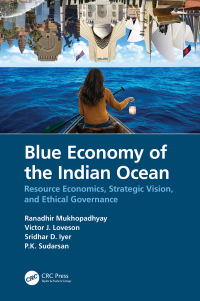Buy Blue Economy of the Indian Ocean: Resource Economics, Strategic Vision, and Ethical Governance 1st Edition PDF ebook by author Ranadhir Mukhopadhyay; Victor J. Loveson; Sridhar D. Iyer; P.K. Sudarsan – published by CRC Press in 2021 and save up to 80% compared to the print version of this textbook. With PDF version of this textbook, not only save you money, you can also highlight, add text, underline add post-it notes, bookmarks to pages, instantly search for the major terms or chapter titles, etc.
You can search our site for other versions of the Blue Economy of the Indian Ocean: Resource Economics, Strategic Vision, and Ethical Governance 1st Edition PDF ebook. You can also search for others PDF ebooks from publisher CRC Press, as well as from your favorite authors. We have thousands of online textbooks and course materials (mostly in PDF) that you can download immediately after purchase.
Note: e-textBooks do not come with access codes, CDs/DVDs, workbooks, and other supplemental items.
eBook Details:
Full title: Blue Economy of the Indian Ocean: Resource Economics, Strategic Vision, and Ethical Governance 1st Edition
Edition: 1st
Copyright year: 2021
Publisher: CRC Press
Author: Ranadhir Mukhopadhyay; Victor J. Loveson; Sridhar D. Iyer; P.K. Sudarsan
ISBN: 9780429326004, 9783030549091
Format: PDF
Description of Blue Economy of the Indian Ocean: Resource Economics, Strategic Vision, and Ethical Governance 1st Edition:
This book investigates spatial institutional variation and its influence on entrepreneurial activity in the Russian Federation, building on an innovative geometric clustering approach. The book looks into how entrepreneurial entry can be explained by institutional factors at the regional level. Furthermore, it examines the relevance of understanding entrepreneurial ecosystems as systems of interrelated elements whose overall function may be impeded by individual components. Most importantly, substantial evidence is presented that higher levels of regional democratization and the liberties that come with them are essential prerequisites for higher rates of entrepreneurial entry and innovation in Russia. The author draws on a comprehensive panel dataset and an unconventional prediction model approach to account for the interrelatedness of institutions with regard to their effects on entrepreneurship. The heterogeneous transition context of the Russian Federation, which continues to have one of the lowest shares of innovative founders, provides an ideal setting for investigating the tedious efforts to tilt at the windmills of transition. Accordingly, the book is a must-read for researchers, scholars, practitioners and policymakers seeking a better understanding of spatial economics, entrepreneurship, economic development, transition economics, public administration and political studies.





